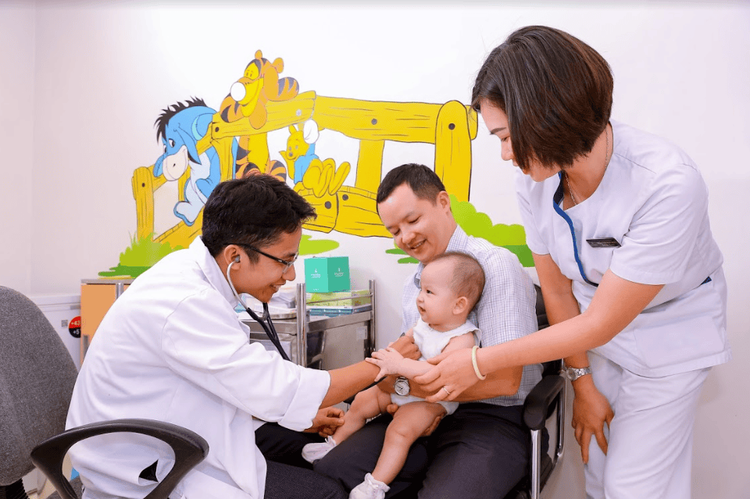This is an automatically translated article.
The article was professionally consulted by Specialist Doctor II Cao Thi Thanh - Pediatrician - Department of Pediatrics - Neonatology - Vinmec Hai Phong International General Hospital.In fact, there are many newborn babies who cannot eat by mouth but need to be nourished by nasogastric tube. This neonatal nasogastric tube method aims to deliver food through the tube all the way to the baby's stomach, and also contributes to the drainage of air from the infant's stomach.
1. An overview of neonatal nasogastric tube placement

Neonatal nasogastric nutrition can be done in the hospital. Insertion of a nasogastric tube to help bring food and medicine into the baby's stomach. A nasogastric tube can be placed before each feeding and then removed, or it can be fixed in place to nourish the infant for a long time.
The important purposes of nasogastric tube placement for infants are:
Drainage, collection of gastric juice samples for laboratory testing, gastric lavage. Help doctors monitor gastrointestinal bleeding in infants. Take medicine and food into the stomach. Contributing to the diagnosis of congenital esophageal atresia in neonates. Indications for feeding through a nasogastric tube in infants include the following subjects:
Children who refuse to eat, eat less, leading to the inability to gain weight. Loss of sucking and swallowing reflexes. Children with gastrointestinal malformations and diseases and phenomena such as abdominal distention, necrotizing enterocolitis, atrophy, congenital gastrointestinal obstruction, etc. Children with respiratory system diseases need to be drained. Gas from the stomach or drainage of gastric juice, typically mechanical ventilation, CPAP... Children experience electrolyte imbalance and elimination. Children have other medical conditions and need to have gastric juices for testing to confirm the diagnosis.

2. Types of nasogastric tubes
Before placing a nasogastric tube in a child, the doctor and medical staff need to prepare a nasogastric tube of the appropriate size for the child's age. In the case of catheterization for the purpose of gastric lavage or drainage of gastric juices and gas, a relatively larger nasogastric tube should be selected. In addition, it is also necessary to prepare a 20ml syringe, clean gloves, pea tray, gauze, tongue depressor, masking tape, stethoscope, cotton swab, acetone, distilled water or physiological saline to serve the treatment. insert a nasogastric tube.Depending on the age of the baby, there are different types of nasogastric tubes with different sizes as follows:
Premature infants: tube size is 5-6. Newborns born at term: tube size 6-8. Young children: tube size is 8. Older children: tube size is 8-10.
3. The process of placing a child's nasogastric tube
Intubation of a nasogastric tube requires strict adherence to the following principles:Use a stethoscope to listen to the heart before and after nasogastric tube insertion because the X-brain reflex can slow the heart rate of the patient. young. The removal of nasogastric tube in infants undergoing esophageal and gastric bypass surgery requires a doctor's appointment. If there is a case of tube slipping, do not automatically reset it, but need to notify the treating doctor for appropriate treatment. Change the tube every 3 days and put it back on the other side. Newborns should have a nasogastric tube placed by mouth. The steps for feeding through the nasogastric tube are carried out as follows:
Inform, prepare and explain to the nursery staff before performing the technique. Ensure sterility by properly washing hands and wearing a mask. Preparing instruments. Wear gloves. Place the child in the supine position, with the head elevated at an angle of 30°, immobilize the patient so that the operation can occur smoothly. Estimate the appropriate length of the tube for the patient by measuring from the baby's mouth or nostrils to the lower earlobe, then down to the midpoint of the nasopharynx to the navel, using a marker on the tube. Warm and smooth the tip of the tube by dipping it in distilled water or physiological saline. Hold the child's head and slowly gently insert the catheter into the baby's nose or mouth, for the mouth use the index finger to push the baby's tongue down and for the nose, point the tube toward the occipital, not upwards. If not, we change to the other side. Gently bend the baby's neck, gently push the tube according to the swallowing rhythm of the baby's body to the part of the tube marked in the previous steps. Check that the catheter is in the correct position by attaching the syringe to the catheter and withdrawing it to see if there is any fluid, use a stethoscope to listen to the epigastrium for the sound of air moving when the syringe is used. Gastric bypass, if there is fluid, measure the pH of the fluid drawn from the catheter and this is also the most common way to check the position of the tube, also X-ray to confirm catheter position. For subjects who are older, awake children, the patient can be asked to cooperate in performing the technique by swallowing and simultaneously inserting the tube, then using a tongue depressor to see if the tube is coiled in the mouth or not, if so. If entanglement is felt, immediately stop, rotate the tube and reset. In case of congenital atrophy of the esophagus, the tube will not be able to reach the level marked with the previous pen. X-ray should be taken to determine the pathology. Observe the child for sudden shortness of breath, cyanosis or not to promptly remove the tube. Secure the tube with tape. Record the date and time of insertion of the nasogastric tube on the nasogastric tube. Clean tools, wash hands. Record the following: date, time, name of person performing nasogastric tube insertion, purpose of intubation, position of nasogastric tube, tube size, volume and nature of gastric juice, send gastric juice test if indicated by treating doctor, patient's reaction if any. Once the catheter is in place, breast milk, formula, or medication is injected into the catheter using a syringe pump or a pump. It is important to note that before nasogastric feeding in neonates, gastric aspirate should be aspirated before each feeding to assess the amount of gastric fluid retention. After the child has finished eating, the doctor will remove the tube from the stomach and at this time, it is necessary to put the child in an upright or slightly tilted position to prevent acid reflux from occurring. If a nasogastric tube is inserted for the purpose of drainage, the outer end of the tube should be inserted into a clean bag secured with tape, positioned lower than the stomach for drainage, and above the stomach. stomach with air drainage. Another thing to note when removing a nasogastric tube is that it is necessary to bend the end of the tube when withdrawing to prevent fluid from flowing into the larynx. A nasogastric tube can be placed for up to 1 week.
4. Risks of nasogastric nutrition
After performing nasogastric tube placement for infants, there may be risks as follows:Mild nosebleeds due to scratching of the nasal mucosa. Blocked nose. Rhinitis Irritation, necrosis of the nasal mucosa. Some cases of feeding through a nasogastric tube in infants also encountered some complications when placing the nasogastric tube in the wrong position or changing the position of the catheter during the infusion of food and drugs into the body such as:
Apnea, bradycardia, cyanosis, decreased SpO2. Perforation of pharynx, esophagus, stomach, duodenum. Choking milk, aspiration pneumonia. Roll, clog the tube. Gastroesophageal reflux causes vomiting. However, in fact, if the child nasogastric tube placement is strictly followed, the complications mentioned above are very rare.
Newborn nasogastric tube is a common method today for babies who cannot breastfeed or eat in the usual way. However, this is only a temporary measure of infant nutrition, providing temporary nutrition until the baby is completely able to eat and drink normally.
As a key area of Vinmec Health system, Pediatrics Department always brings satisfaction to customers and is highly appreciated by industry experts with:
Gathering a team of top doctors and nurses in Pediatrics : consists of leading experts with high professional qualifications (professors, associate professors, doctorates, masters), experienced, worked at major hospitals such as Bach Mai, 108.. Doctors All doctors are well-trained, professional, conscientious, knowledgeable about young psychology. In addition to domestic pediatric specialists, the Department of Pediatrics also has the participation of foreign experts (Japan, Singapore, Australia, USA) who are always pioneers in applying the latest and most effective treatment regimens. . Comprehensive services: In the field of Pediatrics, Vinmec provides a series of continuous medical examination and treatment services from Newborn to Pediatric and Vaccine,... according to international standards to help parents take care of their baby's health from birth to childhood. from birth to adulthood Specialized techniques: Vinmec has successfully deployed many specialized techniques to make the treatment of difficult diseases in Pediatrics more effective: neurosurgery - skull surgery, stem cell transplantation. blood in cancer treatment. Professional care: In addition to understanding children's psychology, Vinmec also pays special attention to the children's play space, helping them to have fun and get used to the hospital's environment, cooperate in treatment, improve the efficiency of medical treatment. Dr. Thanh has worked for 25 years in the treatment of neonatal diseases, of which 23 years worked at the neonatal department of Hai Phong Obstetrics and Gynecology Hospital (with experience in neonatal resuscitation in the operating room/delivery room). + late-term care of premature babies (34 weeks - 37 weeks), 02 years working at Hai Phong Children's Hospital Requesting Clinic.Dr. Thanh is currently working in Pediatrics - Neonatology Department of Vinmec International General Hospital Hai Phong
Please dial HOTLINE for more information or register for an appointment HERE. Download MyVinmec app to make appointments faster and to manage your bookings easily.
Reference source: Portal of Maternal and Child Health Department - Ministry of Health
SEE MORE:
Placing a gastric tube How to feed the patient through a nasogastric tube Note the menu and how to take care of the patient eating through a nasogastric tube














